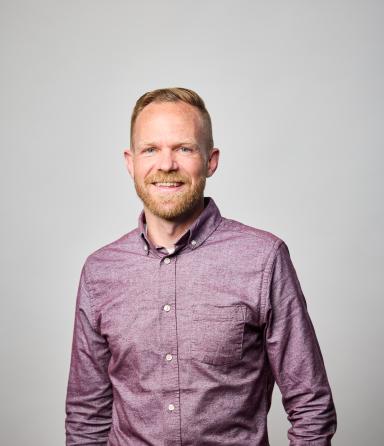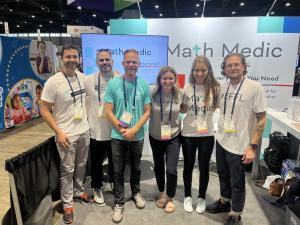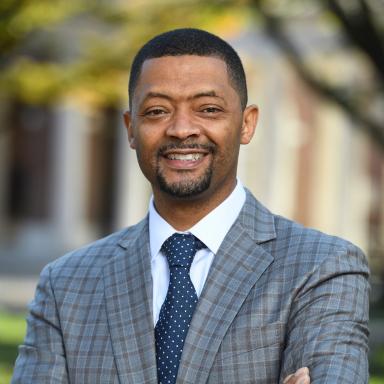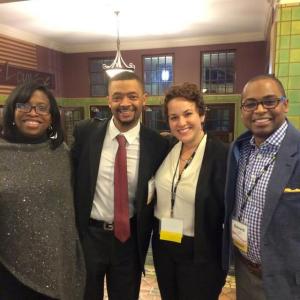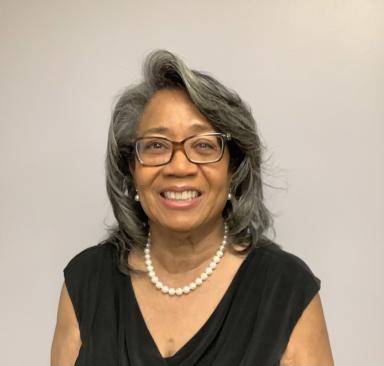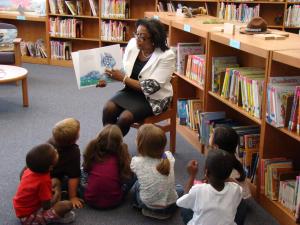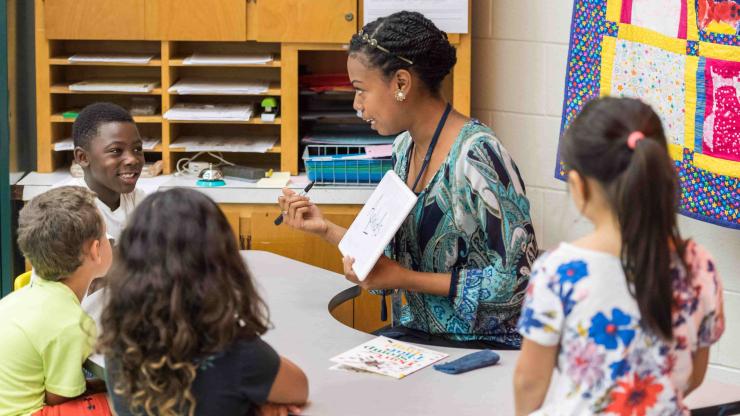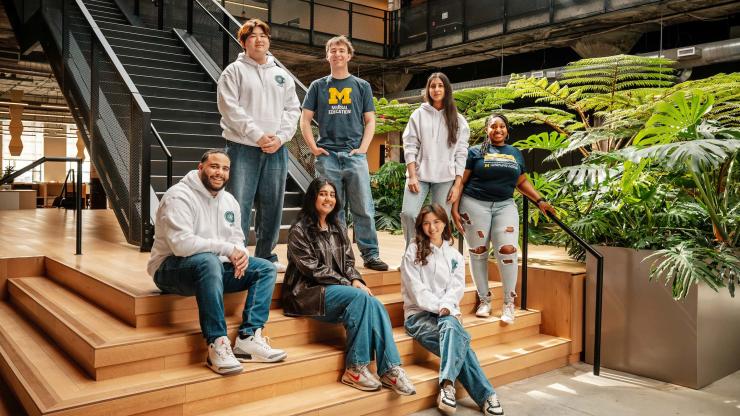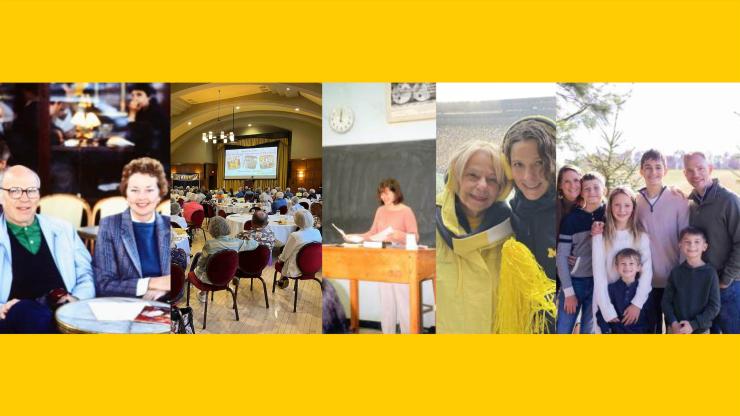Announcing the 2024–25 Alumni Award Recipients
Each year, the Marsal Family School of Education Alumni Awards recognize the incredible accomplishments of our alumni. Selected by a committee of Marsal School faculty, staff, alumni, and current students, the awards are given to alumni who have made significant contributions to their profession, and whose qualities of leadership, innovation, and passion have advanced the field of education.
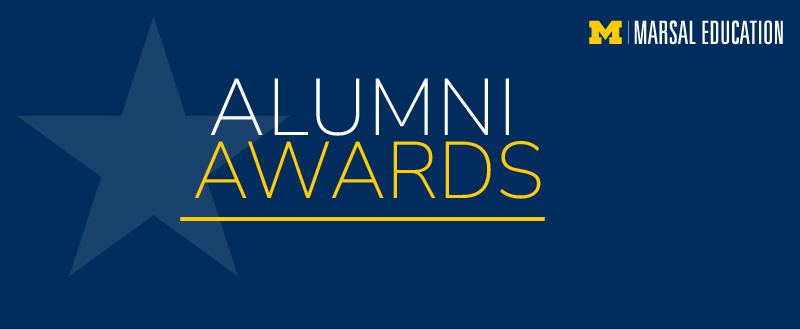
Luke Wilcox
About 10 years ago, Luke Wilcox (BSEd '01, TeachCert '01) started noticing that his mathematics lessons weren't reaching all his students. He wondered whether he could find a more effective way to teach.
Wilcox had been using the same approach he'd seen when he was in high school himself. He would stand in front of the classroom and deliver a lecture while students listened and took notes from neat rows of desks. They would then try a few practice problems and get assessed based on whether they could memorize the information and reproduce it on a test.
"This model works well for some students, but it definitely does not work for all students," he says, adding that it best serves upper middle class, largely white students who have more academic support at home and "understand the rules of school." And it disadvantages other students, especially those from low-income, minority backgrounds.
"Over the course of my career, I realized that the lecture model is an inequitable way to teach mathematics."
This was a problem for Wilcox, especially because he teaches at East Kentwood High School in Kentwood, Michigan, which is the most diverse school in the state of Michigan—and one of the most diverse schools in the nation. East Kentwood has students from over 70 different countries, and has over 70 different languages represented in the student body.
Wilcox started to explore whether there was a more equitable and effective way to teach math. He wanted to shift away from acting like the teacher was the owner of all the knowledge and the one who got to decide how to transfer it to students and then assess them on their learnings.
"The teacher lecturing at the front of the room creates a power hierarchy that disempowers students, which disproportionately has a negative effect on low-income and non-white students," he says.
He collaborated with colleagues at East Kentwood to develop a new approach to teaching math, which centered student engagement and discussion over lectures. In this model, the class starts with students working collaboratively in small groups to discuss different ideas and reach their own understanding of a new concept before the teacher helps the students to learn the formal definitions, theorems, or formulas.
"We realized that getting students talking to each other and doing more of the thinking and reasoning up front, rather than having the teacher always doing all of the work, could be way more effective for the wider variety of types of students that we serve in Kentwood," Wilcox says.
"This creates a student-centered classroom that puts students at the top and gives them ownership of their learning, which drives motivation and excitement for discussing mathematics."
The math colleagues turned their findings into a replicable teaching model called, "Experience First, Formalize Later" (EFFL). And they founded Math Medic, a math curriculum company that helps other teachers implement the same approach in their own classrooms.
Through Math Medic, Wilcox and his colleagues develop and share free downloadable lesson plans that apply EFFL principles across all high school mathematics subjects. Over 1 million lesson plans have been downloaded and used by more than 100,000 teachers across the United States. Wilcox and his colleague, Lindsey Gallas, also founded the nonprofit Math Medic Foundation that provides financial support to help students, teachers, and schools access educational opportunities and math resources.
"I have found that a much higher percentage of my students find success in math through the Experience First, Formalize Later model," says Wilcox. "They feel a much greater sense of belonging in the math classroom and they realize and believe they have valuable ideas to contribute, rather than thinking the teacher knows everything."
The EFFL model also challenges the traditional approach of asking students to memorize information and then reproduce it on a standardized test, which Wilcox says is not the most inspiring way to learn about math.
"That's not about the beauty of mathematics or exciting ways to learn, it's about how to score well on a test, which doesn't send the best message to students," he says. "The Experience First, Formalize Later model is trying to shift away from only using test scores to evaluate how well students are able to understand math, work through different concepts, and communicate their learnings."
At East Kentwood High School, there's convincing evidence that the EFFL approach is making a difference.
Wilcox remembers that he only had 16 students in AP statistics the first time he taught the class. Now, there are usually over 100 students enrolled each year, with a much more diverse makeup. East Kentwood High School had several years where it was credited with the highest number of minority students passing the AP statistics exam in the state of Michigan.
"We want our AP classes to mirror the hallways," he says. "We're not quite there, but we're moving in the right direction."
Wilcox has been recognized for his teaching and contributions to education through the 2013 Presidential Award for Excellence in Math Teaching (for which he was honored with a trip to the White House to meet then-president Barack Obama) and the 2018 Michigan Teacher of the Year Award.
"I couldn't believe that the first Black president in the history of the United States was giving me an award for teaching mathematics," says Wilcox. "I never thought teaching would land me in the White House, never mind shaking hands with the president after he talked about the value of education."
It's fitting that Wilcox's teaching origin story begins with a desire to make a difference. He originally enrolled in Michigan's College of Engineering and was tutoring high school geometry students to make a little money on the side. As word spread about his tutoring skills, he found himself working with eight to 10 students every week, and soon switched to the Marsal School because he loved the work he was doing.
"I realized the impact that I could have on human beings and I decided that teaching was what I wanted to do," he says.
DR. Odis Johnson Jr.
When Odis Johnson Jr. (PhD '03) arrived at the University of Michigan to pursue his doctoral degree, he had many questions he wanted to explore across disciplines, especially through the lens of a Person of Color from a disadvantaged background. He didn't want to stay in one academic lane—and when Michigan helped him appreciate that he didn't need to, it was a transformative experience that set the stage for the rest of his career.
"A great thing about Michigan was that the institution allowed me to be somewhat undefined," he said. "I was interested in education, but I was also very interested in housing, policing, the sociology of race, along with data methodologies—and how they told the story of people like myself.
"Through my doctoral program, I gained the tools and perspective I needed to explore questions that expanded beyond a single discipline," he added. "Michigan was a really defining experience for my career trajectory."
Johnson hasn't stopped working across disciplines since he completed his doctoral degree at the Marsal Family School of Education in 2003, and that has empowered him to conduct innovative research that's driving social change across many pressing issues.
Johnson is now a distinguished transdisciplinary scholar who focuses on social policy, race, and data science and how they structure opportunities for the least advantaged, including African American populations and lower-income households. The depth and range of his professional accomplishments speak to just how expansive his career and research have been.
He's currently the Bloomberg Distinguished Professor of Social Policy and STEM Equity at Johns Hopkins University and has faculty appointments in the Department of Health Policy and Management at the Bloomberg School of Public Health, at the School of Education as Executive Director of the Center for Safe and Healthy Schools, and in the Department of Sociology.
Johnson's scholarship has been published in leading academic journals across 12 scientific disciplines, and he has become a frequently amplified voice on race and equity in the media. He was editor-in-chief of the Sociology of Education, a journal of the American Sociological Association, and his work has been funded by the National Science Foundation (NSF), National Institutes of Health, Joyce Foundation, William T. Grant Foundation, Robert Wood Johnson Foundation, and the Spencer Foundation. He has also served on scientific advisory boards for the NSF Directorate for STEM Education, the U.S. Department of Housing and Urban Development HCV Demonstration, and the U.S. Department of Education, and directs the NSF Institute in Critical Quantitative, Computational, and Mixed Methodologies.
Johnson's work may touch on many different academic realms, but there are common threads across his research, especially with his commitment to advancing educational equity and social justice.
He is currently spearheading multiple projects that aim to promote a more just approach to education, housing, and policing. One of his current projects is looking at how to ensure that teacher instruction is not overly reliant on the forms of discipline that can exacerbate racial and ethnic disparities, like suspensions and expulsions. He's working with 11 schools in Maryland and Missouri to provide culturally responsive professional development training that will help teachers learn a more just approach to maintaining order in their classrooms that focuses more on instruction than social control. He received the Spencer Vision Award for research to conduct this work.
"We are trying to decarcerate instruction to reduce discipline disparities and make instruction less authoritarian," he explained. "We want teachers to use the carrot instead of the stick to keep students interested in learning and get more kids curious about things like science."
This project grew out of his extensive work on school surveillance and security, which has been heavily cited in major media outlets. His ideas about social change garner hundreds of media mentions every year, including 881 in 2023, alone. Many of these were related to school shootings and the surveillance measures implemented to respond to them, including security cameras, resource officers, and metal detectors.
"Communities sometimes have knee-jerk responses to these shootings that hinge on increasing surveillance, which we believe misses the mark," he said. "Rates of injury and death have continued to rise year-over-year for the last eight years, so clearly, something we're doing is not working."
Johnson's research has found that increased surveillance and detection measures don't make schools safer. Instead, they lead to poorer academic outcomes for students, including higher rates of in-school suspensions, lower math scores, and less likelihood of attending college.
"Schools with the harshest suspension policies and highest reliance on surveillance tend to have the lowest levels of mathematics achievements and college entry rates," he said. "This is important because African Americans are four times more likely to be in the schools with the highest reliance on suspension and surveillance."
Students at these schools are also disproportionately likely to come from low-income and single-parent homes, he added. Johnson stresses that a more successful model is to address mental health and equity, which includes ensuring that kids feel respected, connected, and a sense of belonging at school.
He's also advised the Federal Trade Commission on their ongoing investigations into companies that sell surveillance technology to schools, including AI-powered surveillance systems that are marketed for school safety—and often overpromise what they can deliver, he says.
"Our work has been questioning whether those technologies actually keep schools safe," he said. "We're constantly engaging with the nation's thought leadership and public discourse around how to keep schools safe and whether AI-powered technology is the answer."
The future of AI and how it intersects with social justice will remain a focus of his work moving forward.
"We've got to understand how the use of AI-powered technologies affects opportunities and equity in housing, policing, and education," he said.
Another important pillar of his work is ensuring equity across data collection and research methodologies. In this realm, he's helped numerous federal agencies improve data collection for research that addresses public housing, STEM education, and public schools, and he's interrogated issues like racial inequities in the use of police force. He created the nation's first probability sample of fatal interactions with police to investigate whether there are disparities in police homicides and probe the predictors of fatal force by police.
He's also interested in how research methods can be expanded or broadened to be more equitable for researchers themselves—so other marginalized researchers can thrive in every academic discipline.
"Unfortunately, there's a lot of inequity within methodology, where certain methods are assumed to be only practiced by certain populations, and other methods are for other populations," he said. "I want to help ensure that methodological opportunities are available for everyone so that they apply them to conversations in whatever field they choose."
Barbara Eason-Watkins
Barbara Eason-Watkins (ABEd '73, TeachCert '73) didn't intend to work for 50 years before finally retiring from her job as a superintendent in 2024. But it was hard for her to walk away from her decades-long career—and her unwavering commitment to improving public education.
"I loved what I was doing," she said. "I had a real passion for trying to make a difference, especially for students who may not have had the best opportunities from home. I always wanted to make the educational system a place in which all students could thrive."
Eason-Watkins spent the majority of her 50-year career in administration—as a nationally recognized principal, chief education officer for Chicago Public Schools, and longtime superintendent—but she never got very far away from the classroom. She was known for her relentless support for teachers and had a reputation for being "in the weeds" with students.
"I always wanted to stay in touch with what was happening on the ground and make sure everyone felt supported in their work," she said. "At the same time, I wanted to make sure teachers felt empowered to be leaders and have agency over their classroom decisions."
It was a lack of agency that led her to first seek an administrative position. She was teaching in a first-grade classroom in Chicago. She'd found a musician to visit her class and engage with her young students, many of whom hadn't had much exposure to music or various instruments. When the principal of the school found out about her plan, she told Eason-Watkins she couldn't have a musician visit her classroom because she hadn't asked her for permission first.
"I saw how you really have to have some level of control and power in order to make the greatest difference," she said.
Eason-Watkins went on to pursue her first principal position in 1985, and quickly made building relationships a core part of her approach to leadership.
For example: when she was hired as the superintendent for Michigan City Area Schools in Michigan City, Indiana in 2010 after decades in Chicago, people kept asking her, "What are your priorities for the district?"
"And I said, well, I need to find out," she remembers. "It was critically important to listen first to find out what teachers, schools, and students needed."
Eason-Watkins proceeded to spend her first 100 days visiting all 13 schools in the district and speaking with teachers, students, and community organizations. Over the course of her tenure in Michigan City, she led strategic planning for the district and collected 3,000 responses to a survey, which included students from third to 12th grade. She also added students to the planning committee because she knew that students felt like their voices had historically gone unheard.
"It wasn't for me to come in and say, 'you need x, y, z,'" she says. "I wanted to hear from the key stakeholders as to what they are they really consider to be the priorities."
It was a value she prioritized in Chicago as well, noting that she'd seen too many examples of administrators charging into an educational setting with an established agenda, before ever getting input from teachers or other people in the community about local needs.
She jokes that her husband, Irvin, never wanted to go to the grocery store with her in Indiana, because he knew "they'd never get out of the grocery store," as she'd spend so much time chatting with people she ran into. However, he was her greatest cheerleader and supporter, and that enabled her long career.
Eason-Watkins also nurtured her relationships with teachers and empowered them to be leaders, who wouldn't feel as powerless as she did back in her first-grade classroom. She practiced a distributed leadership model, where responsibility and decision-making were shared, before it was even a named concept.
"There was no language for what I was trying to do," she said. "But I understood that you have to have strong engagement, support, and buy-in from teachers."
When teachers were striking in Chicago, she brought them donuts on the picket line. And she constantly worked alongside the leadership of the teachers' unions in her districts.
"It was always of utmost importance to treat people with respect and reassure them that I had their back," she said.
In Chicago, Eason-Watkins was the lead curriculum and instruction strategist for the district, which was the third largest in the nation. When she spearheaded efforts to address the lingering achievement gap in the district's schools, she went to every meeting about the curricular changes and policy reforms so she could learn alongside the teachers and ensure they were set up for success.
She was also deeply invested in the success of students. She launched initiatives that helped prepare students for college, especially first-generation students who lacked the family support they needed to pursue a postsecondary education. And she expanded technical education and career-readiness initiatives, and collaborated with local community groups and unions to offer students apprenticeships and training opportunities in such fields as construction, manufacturing, and culinary arts.
"In many cases, students have capacity, but they don't have the critical support they need to succeed," she said.
She also established new magnet schools in the arts and STEM, and implemented new programs for gifted and talented elementary students.
Eason-Watkins has been recognized for her commitment to education many times throughout her career. She has earned numerous awards for her work, including the Lifetime Achievement Award from the Northwest Indiana Society of Innovators and the Sagamore of the Wabash, which is the highest honor awarded by the governor of Indiana.
Education was, surprisingly, not her original career plan. She was on a pre-med trajectory when she first enrolled at the University of Michigan. One summer, she tutored incarcerated adolescents to earn money for her rent, and met Michigan professor Gwendolyn Calvert Baker through the center where she was working. She couldn't believe how deprived the students had been of educational opportunities; she was also moved by the work of Calvert Baker, whose focus was on race and multicultural education and who was working on a project looking at representation in reading materials.
"By the end of the summer, I said, 'I may be taking a huge risk, but I want to go into education,'" she says.
Eason-Watkins stayed committed to representation and equity through her entire career. She remembers hearing stories about how her mother wasn't allowed to go to the local school in Alabama when she was young. And how her grandfather, a local minister, opened up the church on weekends so African American students had a place to learn.
She wrote her own children's book and worked with an illustrator to center Children of Color in it, so more students could see themselves in the pages. And she knew it was important for her to set an example of what underrepresented students could do. She remembers getting turned away from one of the first jobs she applied to when she showed up for the interview because the district said it wasn't ready for "someone who looks like you."
One of the moments that will always stand out from her 50-year career is when she first started working in Michigan City and a student ran after her as she was leaving the building.
"He said, 'I'm just so happy you're here. I've never seen a superintendent who looks like you,'" she said. "It's always been incredibly important for me to help make sure students see themselves represented."
